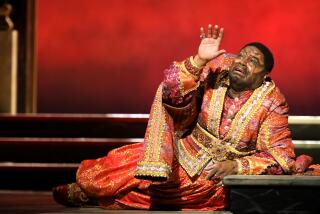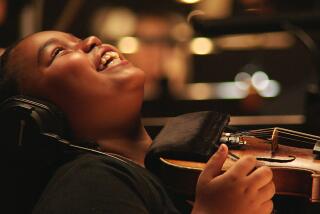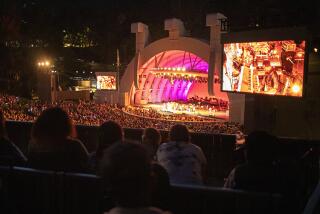Review: ‘Stravinsky in Hollywood’ an illuminating look at his L.A. years
In his fascinating new hour-long documentary, “Stravinsky in Hollywood,” made for European television and now released on DVD by C-Major, Marco Capalbo begins with the oft-quoted statistic that Igor Stravinsky lived in West Hollywood longer than he had anywhere else. The narrator says it with a betcha-didn’t-know-that tone. Everybody always says it that way.
There are two reasons why this Stravinsky statistic never seems to take hold. One is that the music written in Europe remains at the top of the Stravinsky hit parade. The other is because official Los Angeles and its environs have done absolutely nothing to put Stravinsky on the local map. There is no Stravinsky street or theater or park or fountain, no Stravinsky anything.
About to turn 58 and the world’s most famous composer, Stravinsky arrived here with his companion, Vera Sudeikina (whom he would soon marry), in late spring of 1940 and immediately picked up a check for $6,000 from Walt Disney for the use of “Rite of Spring” in “Fantasia.” That summer, Stravinsky made his Hollywood Bowl debut conducting the “Firebird” Suite — the same work that opened the Los Angeles Philharmonic’s Bowl season last week.
Stravinsky soon found a house on North Wetherly Drive above the Sunset Strip, the first property he owned and where the Stravinskys remained for 23 years before moving next door. His heath failing, he left L.A. in 1969 and died two years later in New York.
The focus of Capalbo’s film is how L.A. helped Stravinsky resolve an artistic crisis and invent a new, late style. The value of the film is to give a human face to what is too often thought of as Stravinsky’s most severe and forbidding music by dramatically pitting the composer as a man of order against a Hollywood of chaos.
Here, the composer was free to reinvent himself.
Stravinsky’s first encounters with Hollywood weren’t promising. Like so many other artists, he fled Europe with an eye toward the pictures. He took meetings. He wrote some trial music for a few films, including the 1943 “Jane Eyre,” staring Orson Welles and Joan Fontaine and with a screenplay by Stravinsky’s friend Aldous Huxley.
But unwilling to relinquish an iota of musical control, Stravinsky never ultimately worked in Hollywood, eventually recycling his film efforts into other scores. Capalbo revealingly splices the bits that became a symphonic “Ode” into the scene where Jane meets Rochester, showing Stravinsky’s music doing the seemingly impossible — upstaging Welles.
Capalbo portrays Stravinsky at this point in his life as being in danger of becoming irrelevant. After World War I, he had jettisoned the progressive style of such early works as “Rite of Spring” for a more conservative neo-Classicism. By the ‘40s, that was getting stale. It was too advanced for Hollywood and too “soft-centered” for the European avant-garde, which had taken to booing him.
Meanwhile, he embraced the L.A. lifestyle. One of the film’s treasures is rare footage of Stravinsky in his back yard wearing a bathing suit and showing off his compact physique. He stands on his head and then sits down to drink a glass with a raw egg, savoring it as though it were a fine Scotch.
Stravinsky begins to seem an isolated figure. Only with the arrival of his young assistant, Robert Craft, in 1948, did he liven up. Craft also befriended Arnold Schoenberg, Stravinsky’s nemesis, and from that came the roots of Stravinsky finding that new order from chaos.
After Schoenberg’s death in 1951, Stravinsky, shown in more great home movies finding inspiration from trips in his convertible to the desert with Craft and Vera and from his increasing involvement in the Russian Orthodox church, took up the 12-tone system Schoenberg had developed, but which Stravinsky made his own.
All of this is illuminating as far as it goes. But “Stravinsky in Hollywood” might have gone further. Stravinsky, in fact, drew from a wealth of L.A. resources. He relished socializing with artists and stars and spiritualists. His took nearly as much inspiration from L.A.’s early music pioneers as he did from 12-tone techniques.
Stravinsky really was in Hollywood, and Hollywood knew it. Capalbo somewhat condescendingly shows excerpts from the television work “The Flood,” which CBS commissioned Stravinsky to write. Stravinsky dubbed it “The Flop.”
Still, Stravinsky remained for his three decades here a celebrity. For an 80th birthday celebration in 1962 at the Bowl, the composer drew, The Times noted, a bigger crowd than had a previous night of Tchaikovsky.
Looking for some Stravinsky statistics of my own, I made a quick search of The Times database. In 1962, Stravinsky’s name came up 232 times in the paper. That was 34 more mentions than Marilyn Monroe and only 36 fewer than Frank Sinatra.
Yes, Stravinsky really was not only in Hollywood but also part of Hollywood. And Hollywood’s ultra-short memory needs regular reminding.
More to Read
The biggest entertainment stories
Get our big stories about Hollywood, film, television, music, arts, culture and more right in your inbox as soon as they publish.
You may occasionally receive promotional content from the Los Angeles Times.







